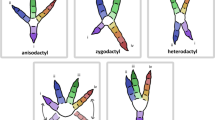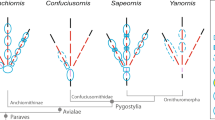Abstract
The foot structure of piciform and coraciiform birds is examined in detail. Certain similarity in foot structure between woodpeckers and woodhoopoes is shown and provides the basis for the model of the evolutionary formation of the zygodactyl foot. It is shown that African mousebirds and the Madagascan Leptosomus discolor are probably the closest relatives of piciforms. A brief review of fossil groups presumably belonging to the piciform stem is provided.
Similar content being viewed by others
References
P. Ballmann, “Die Vogel aus der altburgidalen Spaltenfüllung von Wintershof (West) bei Eichstätt in Bayern,” Zitteliana 1(1), 5–60 (1969).
W. J. Bock and W. W. Miller, “The Scansorial Foot of Woodpeckers, with Comments on the Evolution of Perching and Climbing Feet in Birds,” Am. Mus. Novit., No. 1931, 1–45 (1959).
P. J. K. Burton, “Anatomy and Evolution of the Feeding Apparatus in the Avian Orders Coraciiforms and Piciformes,” Bull. Brit. Mus. Natur. Hist., Zool. Ser. 47(6), 331–343 (1984).
G. A. Clark, “Toe Fusion in Oscines,” Wilson Bull. 93(1), 67–76 (1981).
J. Cracraft, “The Relationships and Evolution of the Rollers: Families Coraciidae, Brachypteraciidae, and Leptosomatidae,” Auk 88(4), 723–752 (1971).
J. Cracraft, “Toward a Phylogenetic Classification of the Recent Birds of the World (Class Aves),” Auk 98(4), 681–714 (1981).
A. Feduccia, “A Model for the Evolution of Perching Birds,” Syst. Zool. 26(1), 19–31 (1977).
A. Feduccia, The Origin and Evolution of Birds, 2nd ed. (Yale Univ. Press, New Heaven-London, 1999).
C. J. O. Harrison and C. A. Walker, “Birds of the British Lower Eocene,” Tert. Res. Spec. Pap., No. 3, 1–52 (1977).
M. Herremanns and M. Louette “Sexual Dimorphism in the Juvenile Plumage of the Courol Leptosomus discolor and Consideration of Its Affinities,” Bull. Brit. Ornithol. Club. 112, 182–185 (1992).
E. Höfling and H. M. F. Alvarenga, “Osteology of the Shoulder Girdle in the Piciformes, Passeriformes and Related Groups of Birds,” Zool. Anz. 240(2), 196–208 (2001).
P. Houde and S. L. Olson, “A Radiation of Coly-like Birds from the Eocene of North America (Aves: Sandcoleiformes New Order),” Natur. Hist. Mus. Los Angeles County. Sci. Ser., No. 36, 137–160 (1992).
U. S. Johansson and P. G. P. Ericson, “Molecular Support for a Sister Group Relationship between Pici and Galbulae (Piciformes sensu Wetmore 1960),” J. Avian Biol. 34(2), 185–197 (2003).
S. M. Lanyon and R. M. Zink, “Genetic Variation in Piciforms: Monophyly and Generic and Familial Relationships,” Auk 104(4), 724–732 (1987).
L. P. Korzun, “On the Trophic Adaptations in Arboreal Birds: Key Adaptation in Endemic Madagascar Coraciforms (Brachypteraciidae and Leptosomatidae),” Zool. Zh. 67(4), 589–599 (1988).
L. P. Korzun, “Evolution of Trophic Adaptations in Wood Arboreal Birds,” Doctoral Dissertation in Biology (MGU, Moscow, 1998).
E. N. Kurochkin, “Methods for the Study of Fossil Birds,” in Routine Methods for the Study of the History of Modern Ecosystems (Nauka, Moscow, 1979), pp. 152–163 [in Russian].
B. C. Livezey and R. L. Zusi, “Higher-order Phylogenetics of Modern Aves Based on Comparative Anatomy,” Neth. J. Zool. 51(2), 179–205 (2001).
A. Manegold “Zur phylogenie und Evolution der “Racken”-, Specht-und Sperlingsvögel (“Coraciiforms”, Piciformes und Passeriformes: Aves),” Unpublished PhD Theses (Freie Univ., Berlin, 2005).
D. Maurer and R. J. Raikow, “Appendicular Myology, Phylogeny, and Classification of the Avian Order Coraciiforms (Including Trogoniformes),” Ann. Carnegie Mus. Natur. Hist. 50(18), 417–434 (1981).
G. Mayr, “’Coraciiform’ und ‘Piciforme’ Kleinvogel aus dem Mittel-Eozän der Grube Messel (Hessen, Deutschland),” Cour. Forsch. Senkenb. 205, 1–110 (1998).
G. Mayr, “New Specimens of the Middle Eocene Fossil Mousebird Selmes absurdipes Peters 1999,” Ibis 143(3), 427–434 (2001).
G. Mayr, “A New Species of Plesiocathartes (Aves: ?Leptosomidae) from the Middle Eocene of Messel, Germany,” PaleoBios. 22(1), 10–20 (2002).
G. Mayr, “The Phylogenetic Relationships of the Early Tertiary Primoscenidae and Sylphornithidae and the Sister Taxon of Crown Group Piciforms,” J. Ornithol. 145(3), 188–198 (2004).
G. Mayr, A. Manegold, and U. F. Johansson. “Monophyletic Groups within ‘Higher Land Birds’—Comparison of Morphological and Molecular Data,” J. Zool. Syst. Evol. Res. 41(4), 233–248 (2003).
W. deW. Miller, “The Deep-Plantar Tendons in the Puffbirds, Jacamars, and Their Allies,” Auk 36(2), 285–286 (1919).
C. Mourer-Chauviré, “Le gisement du Bretou (Phosphorites du Quercy, Tarn-et-Garonne, France) et sa faune de vertébrés de l’Eocène supérieur: 2. Oiseaux,” Palaeontographica, Ser. A 205(1–6), 29–50 (1988).
S. L. Olson, “Evidence for a Polyphyletic Origin of the Piciformes,” Auk 100(1), 126–133 (1983).
F. Richardson, “Adaptive Modifications for Tree-Trunk Foraging in Birds,” Univ. Calif. Publ. Zool. 46, 317–368 (1942).
C. G. Sibley and J. E. Ahlquist, Phylogeny and Classification of Birds: A Study in Molecular Evolution (Yale Univ. Press, New Heaven-London, 1990).
S. F. Simpson and J. Cracraft, “The Phylogenetic Relationships of the Piciformes (Class Aves),” Auk 98(3), 481–494 (1981).
G. Steinbacher, “Funktionell-anatomische Untersuchungen an Vogelfüßen mit Wendezehen und Rückzehen,” J. Ornithol. 83(2), 214–282 (1935).
M. Stolpe, “Physiologisch-anatomische Untersuchungen über die hintere Extremitat der Vögel,” J. Ornithol. 80(2), 161–247 (1932).
E. V. Swierczewski and R. J. Rakow, “Hindlimb Morphology, Phylogeny and Classification of the Piciformes,” Auk 98(3), 466–480 (1981).
A. Wetmore, “A Classification for the Birds of the World,” Smith. Misc. Coll. 139(1), 1–37 (1960).
H. Winkler and W. J. Bock, “Analyse der Kräfteverhältnisse bei Klettervögeln,” J. Ornithol. 117(4), 397–418 (1976).
N. V. Zelenkov and F. Ya. Dzerzhinsky, “Hind Limb Structure and Climbing in Woodpeckers,” Zool. Zh. 85(3), 395–410 (2006).
A. V. Zinov’ev, “On the Previously Unknown Tendon in Passerine Birds and the Mechanism of Branch Grappling,” Zool. Zh. 72(4), 146–149 (1993).
A. V. Zinov’ev, “On the Origin of Heterodactyly in the Trogoniformes (Aves: Trogoniformes),” in 4th Scientific Conference in Memory of Professor V.V. Stanchinskii (Smolensk. Gos. Ped. Univ., Smolensk, 2004), pp. 374–378 [in Russian].
Author information
Authors and Affiliations
Additional information
Original Russian Text © N.V. Zelenkov, 2007, published in Paleontologicheskii Zhurnal, 2007, No. 3, pp. 56–63.
Rights and permissions
About this article
Cite this article
Zelenkov, N.V. The structure and probable mechanism of evolutionary formation of the foot in piciform birds (Aves: Piciformes). Paleontol. J. 41, 290–297 (2007). https://doi.org/10.1134/S0031030107030082
Received:
Issue Date:
DOI: https://doi.org/10.1134/S0031030107030082




